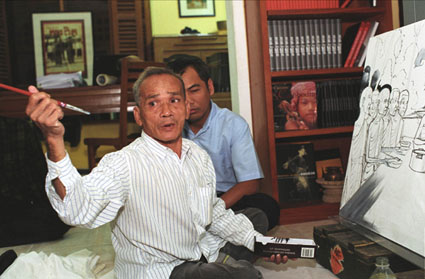|
|
 |
Behind the
Walls of S-21:
Oral Histories
from Tuol Sleng Prison
Produced
by Youk Chhang
2007
30
minutes
|
After five years of waging civil war, Cambodian communist forces
known as the Khmer Rouge marched into Phnom Penh on April 17,
1975. They immediately began forcibly evacuating the residents
of the capital and other cities, displacing more than two
million people to the countryside.
The city dwellers joined rural Cambodians in an ill-fated attempt to
turn the country back to “year zero” and establish a peasant-led
agrarian society. Most of the population was forced to work 14
or more hours a day, building dikes and canals, and growing rice
and other crops.
The Khmer Rouge also abolished schools, money, private property,
courts of law, markets, businesses, the practice of religion,
and nearly all personal freedoms.
Over the next nearly four years, as many as one of every four
Cambodians died from malnutrition, hard labor, or disease. At
least another 200,000 were executed without trial.
Vietnamese troops and the forces of the United Front for the
National Salvation of Kampuchea invaded Cambodia on Christmas
Day 1978. Encountering only a fleeing Khmer Rouge military and a
weakened population, they moved quickly through the country and
reached Phnom Penh on January 7, 1979. By late afternoon they
occupied the city, which was empty save for a few hundred
prisoners of war and people in hiding waiting to escape.
The next day, two Vietnamese officials who accompanied the invasion
were drawn to the stench from a compound in the southern part of
the city. There, they discovered the most important of the Khmer
Rouge prisons, the former Tuol Sleng High School, which was
known to the Khmer Rouge by the code name S-21.
Tuol Sleng was used to detain people the Khmer Rouge considered to
be enemies of the state, including members of their own ranks.
Of the estimated 14,000 men, women, and children held there,
only about a dozen are known to have survived.
Two men who were imprisoned at Tuol
Sleng, Bou Meng and Chum Mei, and a former guard, Him Huy, were
interviewed for this film in 2006, more than 25 years after the
tragedy of Democratic Kampuchea.
Funding for this project was generously provided by the Soros
Foundation’s Open Society Institute under its Documents and
Confronting the Past Affinity Group Project Support for DC-Cam's
operations is provided by the US Agency for International
Development (USAID) and Swedish International Development Agency
(Sida).
|